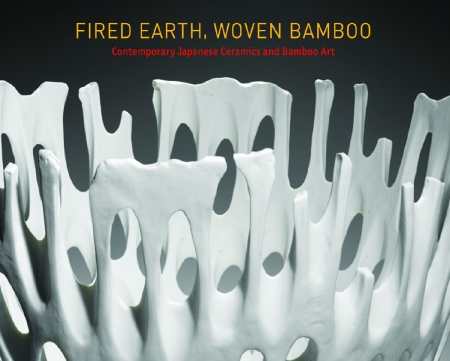Fired Earth, Woven Bamboo
Contemporary Japanese Ceramics and Bamboo Arts
This fine showcase of Japanese art displays in clear photographs pottery that is on par with famous paintings and sculptures.
The Asian art collection of Boston’s Museum of Fine Arts has long been known as one of the best such collections in the United States. The museum’s new photo book, Fired Earth, Woven Bamboo, serves as a good reminder of why that’s true.
The MFA’s holdings include the largest collection of Japanese artwork of any museum outside Japan. It’s a fitting location for the exhibit depicted in the book, which displays the collection of Stanley and Mary Ann Snider. Fired Earth, Woven Bamboo nicely combines photos of pieces from the exhibit with a brief history of the movements in Japanese art that inspired their creation.
A museum book has multiple purposes, and Fired Earth, Woven Bamboo suits each of them. The collection includes enough background information to serve as a companion to the art exhibit and a pleasing souvenir for visitors. Just as important, the quality and diversity of the art objects featured will provide inspiration for aficionados to pay a visit to the museum. Pieces like a blue and white ceramic lantern by Kato Mokuzaemon II, the famous 1948 Cloud sculpture by Hayashi Yasuo, and Yamada Hikaru’s avant-garde shape assortments all stand out on the page. Newer ceramics by artists including Sakiyama Takayuki, Kondo Takahiro, and Kato Yasukage show how the craft of Japanese potters has evolved in ways that combine tradition with bolder colors and designs. The bamboo objects look even better, with their textures beautifully captured by the photography. From Tanabe Chikuunsai II’s beautifully simple 1940s woven flower basket to Torii Ippo’s 2003 mashup Flight, the bamboo works also demonstrate the interplay of tradition and modernity, form and function.
The text does an effective job of giving collectors informative background on the pieces and the shifts in Japanese art that made them possible, but it may prove daunting to more casual readers. The back of the book includes twenty pages of biographical notes about the artists featured, briefly highlighting their education and careers, and the volume includes a note from the Sniders.
In its discussion of how Japanese craftsman began to use their skills to produce works for artistic rather than purely functional reasons, the book quotes artist Hayashi Yasuo: “I wanted it to be seen as a mode of expression on a par with painting and sculpture.” The variety of art pieces in Fired Earth, Woven Bamboo serves as evidence of how well this goal was achieved.
Reviewed by
Jeff Fleischer
Disclosure: This article is not an endorsement, but a review. The publisher of this book provided free copies of the book to have their book reviewed by a professional reviewer. No fee was paid by the publisher for this review. Foreword Reviews only recommends books that we love. Foreword Magazine, Inc. is disclosing this in accordance with the Federal Trade Commission’s 16 CFR, Part 255.

